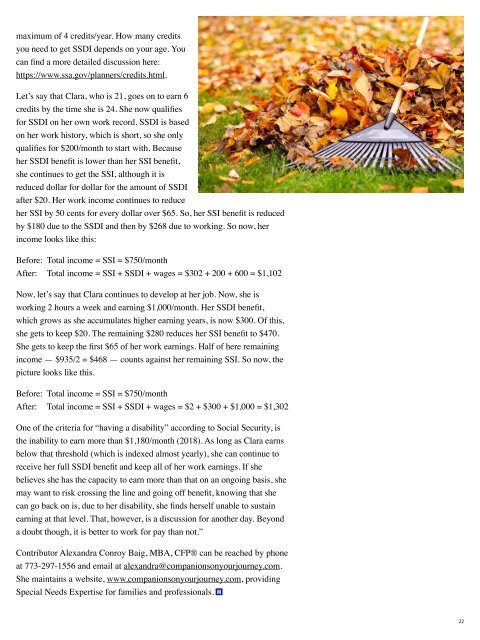Milestones Magazine - Summer 2019
Helping individuals with disabilities and their families achieve and celebrate events and milestones in their lives.
Helping individuals with disabilities and their families achieve and celebrate events and milestones in their lives.
Create successful ePaper yourself
Turn your PDF publications into a flip-book with our unique Google optimized e-Paper software.
maximum of 4 credits/year. How many credits<br />
you need to get SSDI depends on your age. You<br />
can find a more detailed discussion here:<br />
https://www.ssa.gov/planners/credits.html.<br />
Let’s say that Clara, who is 21, goes on to earn 6<br />
credits by the time she is 24. She now qualifies<br />
for SSDI on her own work record. SSDI is based<br />
on her work history, which is short, so she only<br />
qualifies for $200/month to start with. Because<br />
her SSDI benefit is lower than her SSI benefit,<br />
she continues to get the SSI, although it is<br />
reduced dollar for dollar for the amount of SSDI<br />
after $20. Her work income continues to reduce<br />
her SSI by 50 cents for every dollar over $65. So, her SSI benefit is reduced<br />
by $180 due to the SSDI and then by $268 due to working. So now, her<br />
income looks like this:<br />
Before: Total income = SSI = $750/month<br />
After: Total income = SSI + SSDI + wages = $302 + 200 + 600 = $1,102<br />
Now, let’s say that Clara continues to develop at her job. Now, she is<br />
working 2 hours a week and earning $1,000/month. Her SSDI benefit,<br />
which grows as she accumulates higher earning years, is now $300. Of this,<br />
she gets to keep $20. The remaining $280 reduces her SSI benefit to $470.<br />
She gets to keep the first $65 of her work earnings. Half of here remaining<br />
income — $935/2 = $468 — counts against her remaining SSI. So now, the<br />
picture looks like this.<br />
Before: Total income = SSI = $750/month<br />
After: Total income = SSI + SSDI + wages = $2 + $300 + $1,000 = $1,302<br />
One of the criteria for “having a disability” according to Social Security, is<br />
the inability to earn more than $1,180/month (2018). As long as Clara earns<br />
below that threshold (which is indexed almost yearly), she can continue to<br />
receive her full SSDI benefit and keep all of her work earnings. If she<br />
believes she has the capacity to earn more than that on an ongoing basis, she<br />
may want to risk crossing the line and going off benefit, knowing that she<br />
can go back on is, due to her disability, she finds herself unable to sustain<br />
earning at that level. That, however, is a discussion for another day. Beyond<br />
a doubt though, it is better to work for pay than not.”<br />
Contributor Alexandra Conroy Baig, MBA, CFP® can be reached by phone<br />
at 773-297-1556 and email at alexandra@companionsonyourjourney.com.<br />
She maintains a website, www.companionsonyourjourney.com, providing<br />
Special Needs Expertise for families and professionals. M<br />
22











